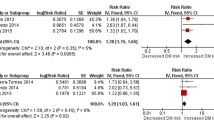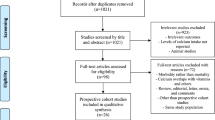Abstract
Serum calcium measured in 27,158 subjects in 1994 and the calcium-sensing receptor polymorphism rs17251221 genotyped in 9,404 subjects were related to cardiovascular risk factors, incident myocardial infarction (MI), type 2 diabetes (T2DM), cancer and death during follow-up until 2008–2010. In a Cox regression model with adjustment for age, gender, smoking and body mass index, subjects with serum calcium 2.50–2.60 mmol/L had a significantly increased risk of incident MI [n = 1,802, hazards ratio (HR) 1.40, 95 % confidence interval (CI) 1.18, 1.66] and T2DM (n = 705, HR 1.49, 95 % CI 1.15, 1.94) and a significantly reduced risk of cancer (n = 2,222, HR 0.73, 95 % CI 0.62, 0.86) as compared to subjects with serum calcium 2.20–2.29 mmol/L. For rs17251221 there was a mean difference in serum calcium of 0.05 mmol/L between major and minor homozygote genotypes. No consistent, significant relation between rs17251221 and risk factors or the major hard endpoints were found. The minor homozygote genotype (high serum calcium) had a significant twofold increased risk (HR 2.32, 95 % CI 1.24, 4.36) for prostate cancer, as compared to the major homozygote. This may be clinically important if confirmed in other cohorts.

Similar content being viewed by others
Abbreviations
- BMI:
-
Body mass index
- CASR:
-
Calcium-sensing receptor
- CI:
-
Confidence intervals
- CVD:
-
Cardiovascular disease
- HbA1c :
-
Glycated haemoglobin
- HR:
-
Hazard ratio
- LD:
-
Linkage disequilibrium
- MI:
-
Myocardial infarction
- PTH:
-
Parathyroid hormone
- SNPs:
-
Single nucleotide polymorphisms
- T2DM:
-
Type 2 diabetes
References
Jorde R, Sundsfjord J, Fitzgerald P, Bønaa KH. Serum calcium and cardiovascular risk factors and diseases: the Tromsø study. Hypertension. 1999;34:484–90.
Kesteloot H, Geboers J. Calcium and blood pressure. Lancet. 1982;1:813–5.
Lind L, Jakobsson S, Lithell H, Wengle B, Ljunghall S. Relation of serum calcium concentration to metabolic risk factors for cardiovascular disease. BMJ. 1988;297:960–3.
Fraser A, Williams D, Lawlor DA. Associations of serum 25-hydroxyvitamin D, parathyroid hormone and calcium with cardiovascular risk factors: analysis of 3 NHANES cycles (2001–2006). PLoS ONE. 2010;5:e13882.
Sun G, Vasdev S, Martin GR, Gadag V, Zhang H. Altered calcium homeostasis is correlated with abnormalities of fasting serum glucose, insulin resistance, and beta-cell function in the Newfoundland population. Diabetes. 2005;54:3336–9.
Lind L, Skarfors E, Berglund L, Lithell H, Ljunghall S. Serum calcium: a new, independent, prospective risk factor for myocardial infarction in middle-aged men followed for 18 years. J Clin Epidemiol. 1997;50:967–73.
Foley RN, Collins AJ, Ishani A, Kalra PA. Calcium-phosphate levels and cardiovascular disease in community-dwelling adults: the Atherosclerosis Risk in Communities (ARIC) Study. Am Heart J. 2008;156:556–63.
Larsson TE, Olauson H, Hagström E, Ingelsson E, Arnlöv J, Lind L, Sundström J. Conjoint effects of serum calcium and phosphate on risk of total, cardiovascular, and noncardiovascular mortality in the community. Arterioscler Thromb Vasc Biol. 2010;30:333–9.
Block GA, Klassen PS, Lazarus JM, Ofsthun N, Lowrie EG, Chertow GM. Mineral metabolism, mortality, and morbidity in maintenance hemodialysis. J Am Soc Nephrol. 2004;158:2208–18.
Dhingra R, Sullivan LM, Fox CS, Wang TJ, D’Agostino RB Sr, Gaziano JM, Vasan RS. Relations of serum phosphorus and calcium levels to the incidence of cardiovascular disease in the community. Arch Intern Med. 2007;167:879–85.
Van Hemelrijck M, Hermans R, Michaelsson K, Melvin J, Garmo H, Hammar N, Jungner I, Walldius G, Holmberg L. Serum calcium and incident and fatal prostate cancer in the Swedish AMORIS study. Cancer Causes Control. 2012;23:1349–58.
Halthur C, Johansson AL, Almquist M, Malm J, Grönberg H, Manjer J, Dickman PW. Serum calcium and the risk of prostate cancer. Cancer Causes Control. 2009;20:1205–14.
Almquist M, Manjer J, Bondeson L, Bondeson AG. Serum calcium and breast cancer risk: results from a prospective cohort study of 7,847 women. Cancer Causes Control. 2007;18:595–602.
Sprague BL, Skinner HG, Trentham-Dietz A, Lee KE, Klein BE, Klein R. Serum calcium and breast cancer risk in a prospective cohort study. Ann Epidemiol. 2010;20:82–5.
Chung M, Balk EM, Brendel M, Ip S, Lau J, Lee J, Lichtenstein A, Patel K, Raman G, Tatsioni A, Terasawa T, Trikalinos TA. Vitamin D and calcium: a systematic review of health outcomes. Evid Rep Technol Assess. 2009;183:1–420.
Wang L, Manson JE, Sesso HD. Calcium intake and risk of cardiovascular disease: a review of prospective studies and randomized clinical trials. Am J Cardiovasc Drugs. 2012;12:105–16.
Bolland MJ, Avenell A, Baron JA, Grey A, MacLennan GS, Gamble GD, Reid IR. Effect of calcium supplements on risk of myocardial infarction and cardiovascular events: meta-analysis. BMJ. 2010;341:c3691. doi:10.1136/bmj.c3691.
Brown EM, MacLeod RJ. Extracellular calcium sensing and extracellular calcium signaling. Physiol Rev. 2001;81:239–97.
Kapur K, Johnson T, Beckmann ND, Sehmi J, Tanaka T, Kutalik Z, Styrkarsdottir U, Zhang W, Marek D, Gudbjartsson DF, Milaneschi Y, Holm H, Diiorio A, Waterworth D, Li Y, Singleton AB, Bjornsdottir US, Sigurdsson G, Hernandez DG, Desilva R, Elliott P, Eyjolfsson GI, Guralnik JM, Scott J, Thorsteinsdottir U, Bandinelli S, Chambers J, Stefansson K, Waeber G, Ferrucci L, Kooner JS, Mooser V, Vollenweider P, Beckmann JS, Bochud M, Bergmann S. Genome-wide meta-analysis for serum calcium identifies significantly associated SNPs near the calcium-sensing receptor (CASR) gene. PLoS Genet. 2010;6:e1001035.
O’Seaghdha CM, Yang Q, Glazer NL, Leak TS, Dehghan A, Smith AV, Kao WH, Lohman K, Hwang SJ, Johnson AD, Hofman A, Uitterlinden AG, Chen YD, GEFOS Consortium, Brown EM, Siscovick DS, Harris TB, Psaty BM, Coresh J, Gudnason V, Witteman JC, Liu YM, Kestenbaum BR, Fox CS, Köttgen A. Common variants in the calcium-sensing receptor gene are associated with total serum calcium levels. Hum Mol Genet. 2010;19:4296–303.
Jacobsen BK, Eggen AE, Mathiesen EB, Wilsgaard T, Njølstad I. Cohort profile: the Tromso Study. Int J Epidemiol. 2012;41:961–7.
Grimnes G, Emaus N, Joakimsen RM, Figenschau Y, Figenschau Y, Jenssen T, Njølstad I, Schirmer H, Jorde R. Baseline serum 25-hydroxyvitamin D concentrations in the Tromsø Study 1994–95 and risk of developing type 2 diabetes mellitus during 11 years of follow-up. Diabet Med. 2010;27:1107–15.
Jorde R, Schirmer H, Wilsgaard T, Joakimsen RM, Mathiesen EB, Njølstad I, Løchen ML, Figenschau Y, Berg JP, Svartberg J, Grimnes G. Polymorphisms related to the serum 25-hydroxyvitamin D level and risk of myocardial infarction, diabetes, cancer and mortality. The Tromsø Study. PLoS One. 2012;7:e37295.
Kulathinal S, Karvanen J, Saarela O, Kuulasmaa K. Case-cohort design in practice—experiences from the MORGAM Project. Epidemiol Perspect Innov. 2007;4:15.
Mannsverk J, Wilsgaard T, Njølstad I, Hopstock LA, Løchen ML, Mathiesen EB, Thelle DS, Rasmussen K, Bønaa KH. Age and gender differences in incidence and case fatality trends for myocardial infarction: a 30-year follow-up. The Tromso Study. Eur J Prev Cardiol. 2012;19:927–34.
Joseph J, Svartberg J, Njølstad I, Schirmer H. Risk factors of type 2 diabetes in groups stratified according to metabolic syndrome. A 10-year follow-up of the Tromsø Study. Eur J Epidemiol. 2011;26:117–24.
Rodriguez S, Gaunt TR, Day IN. Hardy–Weinberg equilibrium testing of biological ascertainment for Mendelian randomization studies. Am J Epidemiol. 2009;169:505–14.
Lewontin RC. The interaction of selection and linkage. I. General considerations; heterotic models. Genetics. 1964;49:49–67.
Gaunt TR, Rodríguez S, Day IN. Cubic exact solutions for the estimation of pairwise haplotype frequencies: implications for linkage disequilibrium analyses and a web tool ‘CubeX’. BMC Bioinform. 2007;8:428.
Hagström E, Hellman P, Lundgren E, Lind L, Ärnlöv J. Serum calcium is independently associated with insulin sensitivity measured with euglycemic–hyperinsulinaemic clamp in a community-based cohort. Diabetologia. 2007;50:317–24.
Leifsson BG, Ahrén B. Serum calcium and survival in a large health screening program. J Clin Endocrinol Metab. 1996;81:2149–53.
Kesteloot H, Joossens JV. Relationship of dietary sodium, potassium, calcium, and magnesium with blood pressure. Belgian Interuniversity Research on Nutrition and Health. Hypertension. 1988;12:594–9.
Pittas AG, Dawson-Hughes B, Li T, Van Dam RM, Willett WC, Manson JE, Hu FB. Vitamin D and calcium intake in relation to type 2 diabetes in women. Diabetes Care. 2006;29:650–6.
Park Y, Leitzmann MF, Subar AF, Hollenbeck A, Schatzkin A. Dairy food, calcium, and risk of cancer in the NIH-AARP Diet and Health Study. Arch Intern Med. 2009;169:391–401.
Kaluza J, Orsini N, Levitan EB, Brzozowska A, Roszkowski W, Wolk A. Dietary calcium and magnesium intake and mortality: a prospective study of men. Am J Epidemiol. 2010;171:801–7.
Ward BK, Magno AL, Walsh JP, Ratajczak T. The role of the calcium-sensing receptor in human disease. Clin Biochem. 2012;45:943–53.
Jung J, Foroud TM, Eckert GJ, Flury-Wetherill L, Edenberg HJ, Xuei X, Zaidi SA, Pratt JH. Association of the calcium-sensing receptor gene with blood pressure and urinary calcium in African-Americans. J Clin Endocrinol Metab. 2009;94:1042–8.
Schwartz GG, John EM, Rowland G, Ingles SA. Prostate cancer in African-American men and polymorphism in the calcium-sensing receptor. Cancer Biol Ther. 2010;9:994–9.
Christensen SE, Nissen PH, Vestergaard P, Mosekilde L. Familial hypocalciuric hypercalcaemia: a review. Curr Opin Endocrinol Diabetes Obes. 2011;18:359–70.
Raue F, Pichl J, Dörr HG, Schnabel D, Heidemann P, Hammersen G, Jaursch-Hancke C, Santen R, Schöfl C, Wabitsch M, Haag C, Schulze E, Frank-Raue K. Activating mutations in the calcium-sensing receptor: genetic and clinical spectrum in 25 patients with autosomal dominant hypocalcaemia—a German survey. Clin Endocrinol. 2011;75:760–5.
Acknowledgments
We are indebted to the National Health Screening Service for their participation in collection of data in the fourth survey of the Tromsø Study. The present study was supported by grants from The North Norway Regional Health Authority, The Norwegian Diabetes Association, The Research Council of Norway and The University of Tromsø.
Conflict of interest
None.
Author information
Authors and Affiliations
Corresponding author
Rights and permissions
About this article
Cite this article
Jorde, R., Schirmer, H., Njølstad, I. et al. Serum calcium and the calcium-sensing receptor polymorphism rs17251221 in relation to coronary heart disease, type 2 diabetes, cancer and mortality: the Tromsø Study. Eur J Epidemiol 28, 569–578 (2013). https://doi.org/10.1007/s10654-013-9822-y
Received:
Accepted:
Published:
Issue Date:
DOI: https://doi.org/10.1007/s10654-013-9822-y




